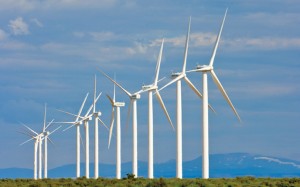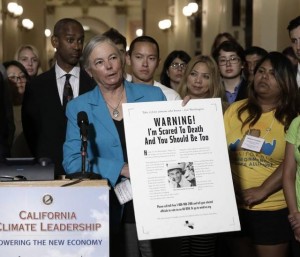This legislative season in California will rank as a big disappointment for environmentalists. The last-minute failure to secure a 50% petroleum reduction by 2030 goal, followed by the defeat (actually postponing) of the bill to set 2030 and 2050 greenhouse gas reduction targets, was a major blow for environmentalists used to getting what they want out of Sacramento. Many commentators are starting to blame Governor Jerry “above the fray” Brown for not doing more to secure passage in the Assembly.
 But lost in these setbacks is the major accomplishment of boosting California’s renewable energy standard to 50% by 2030, coupled with a mandate to double energy efficiency in existing buildings by that year. SB 350 (De Leon) may have been stripped of the petroleum goals, but these other targets are significant accomplishments. The energy efficiency piece set forth a process for the California Energy Commission to set long-term targets and evaluate progress on a regular basis, while the renewable energy mandate essentially just adds the 50% goal into the previous legislation requiring 33% by 2020 — in other words, no new process needs to be created for California to continue down this renewable path.
But lost in these setbacks is the major accomplishment of boosting California’s renewable energy standard to 50% by 2030, coupled with a mandate to double energy efficiency in existing buildings by that year. SB 350 (De Leon) may have been stripped of the petroleum goals, but these other targets are significant accomplishments. The energy efficiency piece set forth a process for the California Energy Commission to set long-term targets and evaluate progress on a regular basis, while the renewable energy mandate essentially just adds the 50% goal into the previous legislation requiring 33% by 2020 — in other words, no new process needs to be created for California to continue down this renewable path.
And finally, SB 350 makes it easier for California to develop a western regional market for renewables that will cover neighboring states and allow California both to import renewables from out-of-state when we need them and export our surplus renewables to other states. The legislation allows the California Independent System Operator, which essentially manages California’s grid, to change its governing rules to allow regional transmission operators to become part of the system. That will facilitate the import and export of renewables, helping California to better balance our in-state supply and ensure that dips in production don’t result in more natural gas-fired power.
So while the legislative season may have largely ended in disappointment, the accomplishments that did occur are worth celebrating for environmentalists.
In another, even bigger setback for the environmental community in California, SB 32 (Pavley), the bill to set greenhouse gas targets for 2030 and 2050, was pulled yesterday and will be tried again next year. The winners are the oil companies, who face tough regulations and competition from California’s climate efforts.
The failure is a big sting for climate advocates in the leading state on this issue. I’m not an expert on the politics, but it appears from press reports that the culprit was oil industry-funded opposition and concern from lawmakers that they won’t have much say in the implementation process. On this score, they are correct: AB 32 was a pretty amazing delegation of authority to the California Air Resources Board, with a bill that clocked in at just twelve pages, leaving the agency with wide rein to implement (compare that to the federal climate legislation back in 2009, which was over a thousand pages of legislated deal-making, rather than being a wide grant of authority to the U.S. Environmental Protection Agency to implement).
So what does the failure mean for ongoing climate efforts? Well, at the very least, we know AB 32 authority still controls, with the state on track to meet the 2020 targets. AB 32 also binds California to those continuing emissions levels beyond 2020, as Cara explained. So that means we’ll have at a minimum a flat-lining of emissions after 2020.
Beyond that authority, many (if not most) of the climate measures under AB 32 come from independent legislative acts, such as renewable energy and energy efficiency mandates (both of which may be strengthened if SB 350 passes today) and SB 375 (Steinberg) on land use, many of which have goals beyond 2020. Incentives for electric vehicles and other renewable fuel technologies will continue, along with federal efforts like the Clean Power Plan and fuel economy standards, plus tax breaks for solar and electric vehicles.
The governor has also issued an executive order that mirrors SB 32 with 2030 goals. But these orders can be changed by future governors, and they ultimately need to be based on legislated authority that may not be there beyond 2020.
Politically speaking, legislators will get one more go at this effort next year. Some say it’s tougher to pass in an election year, but the original AB 32 passed in an election year, and that was a non-presidential one when turnout was lower and presumably more conservative. Maybe SB 32 backers learned some lessons for the next effort.
There’s no denying that a failure in 2016, despite other ongoing measures to tackle climate change, could be a serious setback on reducing emissions — not just here in California but worldwide, given the state’s leadership role. But the state’s climate program will continue regardless. And as extreme weather continues and the benefits of the existing programs are felt by more residents, the politics may improve for these efforts as well.
Well, it doesn’t take a brain surgeon to figure out which industries stand to lose if California transitions to a low-carbon economy. Judging by the latest attacks on SB 350 and SB 32, sprawl developers and the oil industry are feeling a little panicked.
First oil. They sent out a deliberately misleading mailer claiming that SB 350, which seeks to reduce California’s oil consumption in half by 2030, will lead to gas shortages and higher prices. Under the fake pro-consumer-sounding group the California Drivers Alliance, they claim the following:
The Gas Restriction Act of 2015 (SB350) will restrict the use of gas and diesel by 50 percent. This law will limit how often we can drive our own cars. The state will also be collecting and monitoring our personal driving habits and tracking how much gas we use. They’re now reviewing regulations to force automakers to include data monitoring systems in all cars so that regulators will be able to penalize and fine us if we drive too much or use too much gas.
The Sacramento Bee then shot this lying fish in its barrel with a fact check:
The ad exploits a lack of specificity in Senate Bill 350 about what measures the California Air Resources Board could take to reduce petroleum use. But it misleads by suggesting gas rationing, surcharges and citations based on driving habits are in store.
Bottom line: California will be pursuing fuel economy measures, electric vehicles, hydrogen fuel cells and biofuels to meet these objectives — not gas rationing. With battery costs declining, battery electrics should be the dominant vehicles in production by then anyway.
Next comes big sprawl in the guise of the Building Industry Association. The BIA claims SB 32, to extend our greenhouse gas reduction goals to 2030 and 2050, will be an automatic “zero net energy” mandate, leading to an additional $58,000 in costs for each new housing unit, or a price increase of over 12 percent.
However, these numbers once again mislead. First off, the bill is no such mandate for new construction. The California Energy Commission will continue to develop new ways to reduce pollution from new buildings, but it will be on the same trajectory it’s been on for decades, which has saved Californians billions since the 1970s.
Second, most of the costs the BIA tallies are attributed to oversized, expensive solar PV arrays for each new home. Even if all new buildings had to have those arrays (which they don’t), prices will come down by 2030 significantly (80% in the last five years or so), while most neighborhoods would likely pool together on community solar rather than purchasing it individually. Finally, any increase in efficiency measures and solar will only save California residents in reduced energy bills.
For more on the BIA arguments, NRDC has a nice take-down here.
I guess it’s good news these industries are fighting back. If we have any hope of a cleaner, more prosperous and sustainable economy, it will only happen if these industries go the way of the fossils they help burn.
Forget AB 32, now it’s all about SB 32. With the state well on its way to achieving our greenhouse gas reduction goals by 2020, California legislators unveiled yesterday new 2030 goals, with the one letter change in the main bill’s title understating the significance:
On Monday, Democratic lawmakers in the state unveiled a package of four bills that aim to tackle climate change in the state. One of the bills, SB 350, calls for a 50 percent reduction in petroleum use in cars and trucks, a 50 percent increase in energy efficiency in buildings, and a goal of 50 percent of state utilities’ power coming from renewable energy, all by 2030. Current California law requires utilities get 33 percent of their energy from renewable sources, such as wind and solar, by 2050. SB 350’s goals are virtually the same as the ones called for by California Gov. Jerry Brown in his inaugural address in January.
The legislation, if passed (as seems likely given the strong Democratic majorities in both houses), would have significant immediate effects. First, it would help boost the renewables market, which has been stalled of late due to its present trajectory being on course to meet or exceed the 2020 33% goals. With so many projects in the pipeline, utilities have little incentive to keep procuring unless a new target is legislated.
Second, it will help lawsuits like the one against SANDAG in San Diego, with its weak transportation plan that shows emissions increases out to 2050. The lawsuit hinges on the plan (and its environmental review documentation) not complying with the state’s 2050 goals. But those goals are only an executive order from Governor Schwarzenegger. With legislation underfoot, the challenge to the case has a much stronger chance of surviving state supreme court review.
Finally, it will provide more certainty to all the climate change efforts underway, particularly the cap-and-trade program, which would otherwise expire in 2020. With legislation, industry will know what to expect going forward, and revenue for things like affordable housing near transit, energy efficiency upgrades, and high speed rail, will be dependable for years to come.
Let’s hope the legislation can face a clear path to adoption, without getting watered down by special interest giveaways.



